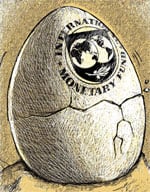CAPITALIZING ON THE CRISIS
RETURN OF THE IMF
As crippled nations beat a path to its door, the IMF is enjoying a dramatic return from near-irrelevance. How it wields its revived power and influence will determine its long-term future.
 |
In both these regions the IMF was criticized for a doctrinaire approach that failed to take account of economic realities. “There was significant criticism of the stringent conditions imposed by the IMF in the past in Korea and elsewhere,” says Nick Chamie, head of emerging markets research at RBC Capital Markets. “Some observers believe the IMF’s approach exacerbated the economic downturn.”
More generally, Chamie says that the IMF’s sensitivity to past criticism appears to be making it more flexible than in the past. “Its fiscal policy prescriptions for Iceland and Hungary, for example, demand fewer cutbacks than similar packages in the past,” he says. It seems that privatization—which along with liberalization and deregulation is a traditional cornerstone of IMF-imposed economic strategies—is no longer a precondition. In Indonesia in the late 1990s, the IMF ordered the closure or privatization of 16 banks. In this crisis it has notably not recommended the privatization of Iceland’s largest mortgage lender, the Housing Financing Fund.
There may be other reasons for this approach. First, given the global crisis, there are few buyers for privatized assets; and second, in many countries liberalization and privatization have already been policy for a decade. Nevertheless, Hauner says the fund is giving more leeway to borrowers. “One outcome of the IMF’s soul-searching is a strategy of greater ownership of policy within countries,” he says.
 |
|
Hauner: “The IMF did a lot of soul-searching… to consider what did and didn’t work.” |
Countries will be able to borrow up to 500% of their quota through the Short-Term Liquidity Facility—countries’ quotas are related to their size in the global economy—meaning that Brazil, for example, could borrow up to $22.5 billion. Loans are for three months at regular IMF interest rates and can be renewed twice within a 12-month period.
As the facility is private, no list of eligible countries is available. However, Argentina has been specifically ruled out, and countries with large current account deficits such as South Africa and Turkey won’t qualify. While the Short-Term Liquidity Facility therefore does nothing for countries with significant problems, it effectively answers criticism that countries in difficulty because of the financial crisis rather than through any fault of their own are not receiving help.
The IMF is likely to be called on by an ever-growing number of countries as global economic growth slows. Chamie at RBC believes that the crisis for emerging markets is still in its early stages. “These are still early days in the turn of the cycle for emerging markets,” he says. “It will be another 12 months before the irrational exuberance of 2004 to 2007 is fully played out in the market, and the economic ramifications may take two years.”
Along the way, even countries with large foreign exchange reserves will be vulnerable because many of them relied heavily on foreign capital in order to unsustainably expand their banking systems, notes Chamie. “That could come back to haunt them,” he says.
 |
|
Chamie: “Someobservers believe the IMF’s approach exacerbated [Asia’s] economic downturn.” |
So should potential future borrowers be wary of turning to the IMF? While the IMF may be trumpeting its newfound flexibility, BoA’s Hauner says that the essential ingredients of policy are likely to remain broadly the same as in the past—because, he says, they are born out of necessity. “In the short term, the only way to effectively contract a country’s financing needs is often through tighter fiscal policy,” he says. “Higher interest rates to attract foreign funds are usually another part of the solution.”
Keller at Barcap agrees that the IMF remains orthodox in the sense “that it will not allow irresponsibility” by borrower governments. “In a country such as Hungary, where the public-debt-to-GDP ratio has reached 66% and roll-over concerns in the domestic bond market limit the government’s borrowing options, it is pivotal to regain markets’ confidence in fiscal sustainability,” he explains.
Trying to implement a fiscal stimulus package—even if desirable from a cyclical perspective—is simply not feasible under such circumstances, says Keller. “Combining the large IMF lending package with a fiscal deficit-reduction policy is not just about ensuring that the IMF gets its money back,” he says. “It’s about boosting investor confidence and preparing the ground for a potentially sharp rebound once global financial markets normalize and the growth slowdown in Europe has bottomed out.”
It seems that the IMF has ruminated on its past actions and has tried to learn from them, although, as Chamie notes, “crisis management remains an emerging science; mistakes will always be made.” The hope is that the new—albeit limited—flexibility the IMF offers is adequate to allow national governments to prevent social conflict while being sufficiently tight to prevent those same governments from continuing to follow reckless economic policies. “It’s a thin line to tread and does pose some risks, but politically, at least, the omens are good,” says Hauner. “Usually, faced with severe economic crisis, a political consensus emerges.”
WAS THE IMF ASLEEP AT THE WHEEL?
Some critics have claimed that the International Monetary Fund was invisible in the run-up to the current crisis. But this analysis ignores both the political realities of the IMF and its quiet insistence that trouble was brewing. “The IMF was marginalized in the United States and elsewhere, with a focus on bilateral arrangements. But it continued to provide accurate assessments of risks building up in various countries,” says Nick Chamie, head of emerging markets research at RBC Capital Markets. “Inevitably, there was little notice taken of these warnings or prescriptions. But that has always been its problem: The IMF is not mandated to tell the rest of the world what to do.”
David Hauner, emerging markets currency strategist at Bank of America, says that, despite such obstacles, the IMF has worked to help the weakest emerging markets economies better withstand the current crisis. “During the relative peaceful times of the earlier part of this decade, the IMF was hard at work helping vulnerable countries,” he says. “The Financial Sector Assessment Program, for example, had been effective in working with central banks to develop stress tests. And the fact that many emerging nations have adopted more responsible policies is partly down to hand-holding by the IMF.”
WHO PAYS THE PIPER?
Two central questions about the International Monetary Fund’s role are important. The first is whether it has sufficient resources. Almost 10% of the fund’s $255 billion in reserves has been lent to Hungary alone. Clearly, more funds are needed, and the only countries with sufficient resources are China, Japan—which has said it could lend up to $200 billion of its foreign exchange reserves to the IMF—and some countries in the Middle East. Logic dictates that if these countries contribute greater resources, they will demand to play a larger role in IMF governance.
The second question is closely linked to a potential political rebalancing of the IMF: Should it have a broader role in managing international finance, and is such a role politically possible? “A significant point has been turned in the global political cycle,” says Nick Chamie, head of emerging markets research at RBC Capital Markets. “The move is now more toward [tighter] regulations. Whether the IMF or another global body could play a more formal role in oversight remains to be seen.”
As Global Finance was going to press, the international community was assembling in Washington, DC, for what has been dubbed Bretton Woods II, an effort to reform the world’s financial architecture. While this is undoubtedly welcome, many observers believe—despite the best efforts of its promoters, the UK’s prime minister Gordon Brown and French president Nicolas Sarkozy—that it is unrealistic for the IMF to play a wider regulatory or overseeing role.
“Regulation is domestic policy,” notes one observer. “The IMF could aid coordination and information-sharing, but it cannot supplant existing regulators. Countries would simply refuse to give up their independence.” Christian Keller, director of emerging markets strategy at Barclays Capital, agrees: “Ideally, the IMF should be able, for example, to order China to devalue its currency or Germany to allow for stronger domestic demand and a smaller current account surplus. But, in practice, it will never be able to do that for political reasons.”
ARCHITECTS OF THEIR OWN DOWNFALL
For some observers, the contagion of the subprime crisis into a broader financial crisis, which engulfed emerging markets in the summer of 2008 as investors became risk averse, is proof that developing nations are destined always to suffer at the hands of the greedy developed world. Certainly, it is true that, unlike Latin American debt in the 1980s or the Asian financial crisis in the late 1990s, the roots of the current emerging markets crisis are not homegrown.
“All countries will face pressure from the global credit crunch, the imbalance of supply and demand for the US dollar and a consequent strong reversal of capital flow,” says Nick Chamie, head of emerging markets research at RBC Capital Markets. “But there are also significant idiosyncratic risks, such as in Argentina, where there are strong macroeconomic imbalances, and more broadly there have been some bad economic policies in place in many countries.”
Countries in EMEA, which is by far the most vulnerable emerging region, have, in particular, shown a cavalier disregard in recent years for economic prudence. Many former Soviet Union states, such as the three Baltic states and Ukraine, Kazakhstan, Bulgaria and Romania, became reliant on foreign capital to stoke credit growth while generating huge current account deficits. Now, confronted with capital outflows and an absence of offshore financing, they are facing currency crises.
“To a large extent the problems faced by the most troubled emerging markets, such as Iceland, are of their own making. They got away with policy mistakes during the period of a benign financial environment, but once the situation changed, they had no chance,” says David Hauner, emerging markets currency strategist at Bank of America. “Other countries that have been less impacted, such as Brazil, have been quite responsible and are affected as bystanders.”
Iceland, which has a population of just 300,000 people and whose three leading banks were nationalized owing more than $60 billion to foreign lenders, is the most extreme example of how economic sanity was discarded by some countries from 2004 to 2007. Having taken on board some of its banks’ debt, Iceland’s debt-to-GDP ratio, which was 29% in 2007, is expected to reach more than 100% at the end of this year while its budget deficit will be 10%.
Hungary, which has received the largest IMF package to date, also provides a telling demonstration of how years of easy global credit and domestic economic mismanagement produced a monster. From 2002 onward, t he country, which had previously been a model of financial conservatism, went on a spending spree that took the budget deficit to 9% of GDP before subsiding slightly until 2006 when it again jumped to 10%. Only an insatiable demand for high-yielding currencies, such as Hungary’s forint, allowed this largesse. Once international investors’ risk aversion increased, a crisis was inevitable.
Laurence Neville



